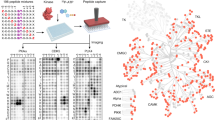Abstract
Growth factors stimulate cells to take up excess nutrients and to use them for anabolic processes. The biochemical mechanism by which this is accomplished is not fully understood but it is initiated by phosphorylation of signalling proteins on tyrosine residues. Using a novel proteomic screen for phosphotyrosine-binding proteins, we have made the observation that an enzyme involved in glycolysis, the human M2 (fetal) isoform of pyruvate kinase (PKM2), binds directly and selectively to tyrosine-phosphorylated peptides. We show that binding of phosphotyrosine peptides to PKM2 results in release of the allosteric activator fructose-1,6-bisphosphate, leading to inhibition of PKM2 enzymatic activity. We also provide evidence that this regulation of PKM2 by phosphotyrosine signalling diverts glucose metabolites from energy production to anabolic processes when cells are stimulated by certain growth factors. Collectively, our results indicate that expression of this phosphotyrosine-binding form of pyruvate kinase is critical for rapid growth in cancer cells.
This is a preview of subscription content, access via your institution
Access options
Subscribe to this journal
Receive 51 print issues and online access
$199.00 per year
only $3.90 per issue
Buy this article
- Purchase on Springer Link
- Instant access to full article PDF
Prices may be subject to local taxes which are calculated during checkout





Similar content being viewed by others
References
Warburg, O. On the origin of cancer cells. Science 123, 309–314 (1956)
Lum, J. J. et al. The transcription factor HIF-1α plays a critical role in the growth factor-dependent regulation of both aerobic and anaerobic glycolysis. Genes Dev. 21, 1037–1049 (2007)
Majumder, P. K. et al. mTOR inhibition reverses Akt-dependent prostate intraepithelial neoplasia through regulation of apoptotic and HIF-1-dependent pathways. Nature Med. 10, 594–601 (2004)
Vander Heiden, M. G. et al. Growth factors can influence cell growth and survival through effects on glucose metabolism. Mol. Cell. Biol. 21, 5899–5912 (2001)
Eigenbrodt, E., Reinacher, M., Scheefers-Borchel, U., Scheefers, H. & Friis, R. Double role for pyruvate kinase type M2 in the expansion of phosphometabolite pools found in tumor cells. Crit. Rev. Oncog. 3, 91–115 (1992)
Zwerschke, W. et al. Modulation of type M2 pyruvate kinase activity by the human papillomavirus type 16 E7 oncoprotein. Proc. Natl Acad. Sci. USA 96, 1291–1296 (1999)
Reiss, N., Kanety, H. & Schlessinger, J. Five enzymes of the glycolytic pathway serve as substrates for purified epidermal-growth-factor-receptor kinase. Biochem. J. 239, 691–697 (1986)
Sale, E. M., White, M. F. & Kahn, C. R. Phosphorylation of glycolytic and gluconeogenic enzymes by the insulin receptor kinase. J. Cell. Biochem. 33, 15–26 (1987)
Presek, P., Reinacher, M. & Eigenbrodt, E. Pyruvate kinase type M2 is phosphorylated at tyrosine residues in cells transformed by Rous sarcoma virus. FEBS Lett. 242, 194–198 (1988)
Mazurek, S., Grimm, H., Boschek, C. B., Vaupel, P. & Eigenbrodt, E. Pyruvate kinase type M2: a crossroad in the tumor metabolome. Br. J. Nutr. 87 (suppl. 1). S23–S29 (2002)
Ong, S. E. & Mann, M. A practical recipe for stable isotope labeling by amino acids in cell culture (SILAC). Nature Protocols 1, 2650–2660 (2006)
Jurica, M. S. et al. The allosteric regulation of pyruvate kinase by fructose-1,6-bisphosphate. Structure 6, 195–210 (1998)
Dombrauckas, J. D., Santarsiero, B. D. & Mesecar, A. D. Structural basis for tumor pyruvate kinase M2 allosteric regulation and catalysis. Biochemistry 44, 9417–9429 (2005)
Yamada, K. & Noguchi, T. Nutrient and hormonal regulation of pyruvate kinase gene expression. Biochem. J. 337, 1–11 (1999)
Villen, J., Beausoleil, S. A., Gerber, S. A. & Gygi, S. P. Large-scale phosphorylation analysis of mouse liver. Proc. Natl Acad. Sci. USA 104, 1488–1493 (2007)
Christofk, H. R. et al. The M2 splice isoform of pyruvate kinase is important for cancer metabolism and tumour growth. Nature 10.1038/nature06734 (this issue)
Hatzivassiliou, G. et al. ATP citrate lyase inhibition can suppress tumor cell growth. Cancer Cell 8, 311–321 (2005)
Root, D. E., Hacohen, N., Hahn, W. C., Lander, E. S. & Sabatini, D. M. Genome-scale loss-of-function screening with a lentiviral RNAi library. Nature Methods 3, 715–719 (2006)
Acknowledgements
We thank W. Hahn for providing the lentiviral shRNA. We thank M. Liu for technical assistance. We thank J. Lee for help in developing the affinity purification techniques. M.G.V.H. is a Damon Runyon Fellow supported by the Damon Runyon Cancer Research Foundation. This research was supported by funding to L.C.C. from the National Institutes of Health.
Author information
Authors and Affiliations
Corresponding author
Supplementary information
Supplementary Information
The file contains Supplementary Discussion; Supplementary Figures 1-4 with Legends illustrating data from control experiments; and Supplementary Tables 1- 2 showing the x-ray crystallography refinement statistics and a list of the phosphopeptides used to assess PKM2 activity. (PDF 282 kb)
Rights and permissions
About this article
Cite this article
Christofk, H., Vander Heiden, M., Wu, N. et al. Pyruvate kinase M2 is a phosphotyrosine-binding protein. Nature 452, 181–186 (2008). https://doi.org/10.1038/nature06667
Received:
Accepted:
Issue Date:
DOI: https://doi.org/10.1038/nature06667
This article is cited by
-
Synthesis, activatory effects, molecular docking and ADME studies as rabbit muscle pyruvate kinase activators of ureido phenyl substituted 1,4-dihydropyridine derivatives
Research on Chemical Intermediates (2024)
-
ESRRG-PKM2 axis reprograms metabolism to suppress esophageal squamous carcinoma progression and enhance anti-PD-1 therapy efficacy
Journal of Translational Medicine (2023)
-
ATM inhibition blocks glucose metabolism and amplifies the sensitivity of resistant lung cancer cell lines to oncogene driver inhibitors
Cancer & Metabolism (2023)
-
KITENIN promotes aerobic glycolysis through PKM2 induction by upregulating the c-Myc/hnRNPs axis in colorectal cancer
Cell & Bioscience (2023)
-
Mediation of PKM2-dependent glycolytic and non-glycolytic pathways by ENO2 in head and neck cancer development
Journal of Experimental & Clinical Cancer Research (2023)
Comments
By submitting a comment you agree to abide by our Terms and Community Guidelines. If you find something abusive or that does not comply with our terms or guidelines please flag it as inappropriate.



